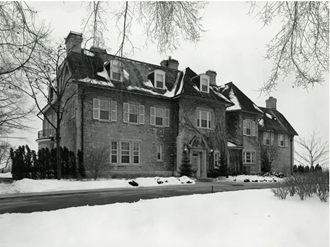24 Sussex: From National Treasure to National Travesty

Credit: Ted Grant / Library and Archives Canada
It was a cold February night, the kind of Canadian cold where you want to stay inside and curl up by the heater with the fireplace channel on TV. Despite the cold, hundreds of people packed onto the benches in the Carleton Dominion-Chalmers Centre in downtown Ottawa for a panel discussion hosted by Heritage Ottawa, Carleton university and Historic Ottawa Development Inc. about 24 Sussex Drive, the perennially dilapidated erstwhile home of the Prime Minister. But this was no hand-wringing vigil – people came to find a path forward for this important historic place.
CPAC: Public Record – The Future of 24 Sussex
24 Sussex is an icon in the national imagination. Like the White House, 10 Downing Street and the Élysée Palace, it combines functions of state with a safe home for the head of state. The house and property at 24 Sussex, located on the traditional unceded territory of the Algonquin Anishinaabe, have been importantly associated with Canada’s political history since Confederation. 24 Sussex is also a cautionary beacon reflecting the way successive federal governments have cared for the heritage places in their care. But what is exciting about the seeming impasse of today is the possibilities that a rehabilitation of the site present. These are opportunities to reflect the past and also to design a place that meets the needs of contemporary government and reflects Canada in the twenty-first century.
A Storied Past
The graceful stone house was built at 24 Sussex at the time of Confederation by Joseph Merrill Currier, a local lumber baron and businessman. Currier built the house as a wedding gift for his third wife, Hannah Wright. It was located with a magnificent view of the Ottawa River, at the confluence of the Ottawa with the Rideau and Gatineau and conveniently located close to Currier’s mills in New Edinburgh. Currier was elected as a member of the first Dominion Parliament.
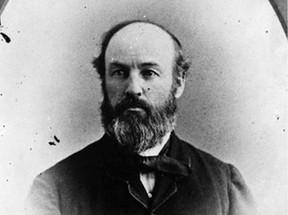
Joseph Merrill Currier. Credit: Library and Archives Canada
Joseph Currier and his second wife, Ann Crosby, were married in January 1861. A month later, he brought her to Manotick to see the impressive mill which he owned there. As she watched the machinery, Ann’s dress became entangled in the works and she was killed. The distraught Currier subsequently sold his interest in the mill and is said never to have visited Manotick again. Watson’s Mill continues to operate and is open to the public. But beware: according to local legend, Ann’s ghost haunts the mill.
Currier sold the house after Hannah’s death to William Cameron Edwards, elected five times to serve in Parliament and, about the time he acquired the house, appointed to the Senate. The house then passed to his nephew, Gordon Edwards, who also worked in the lumber business and was elected to the House of Commons in 1926.
The Government of Canada expropriated the house in the 1940s from Gordon Edwards, who actively resisted. While the initial intent seems to have been to consolidate the land along the Ottawa River, by 1949 the Government had decided to turn the house into a residence for the Prime Minister. Situated across the road from Rideau Hall, the residence of the Governor General, there could hardly be a better location. In 1951, Prime Minister Louis St-Laurent moved in, as has every subsequent Prime Minister except Kim Campbell, until the current Prime Minister refused to occupy the building.
Federal Heritage Building
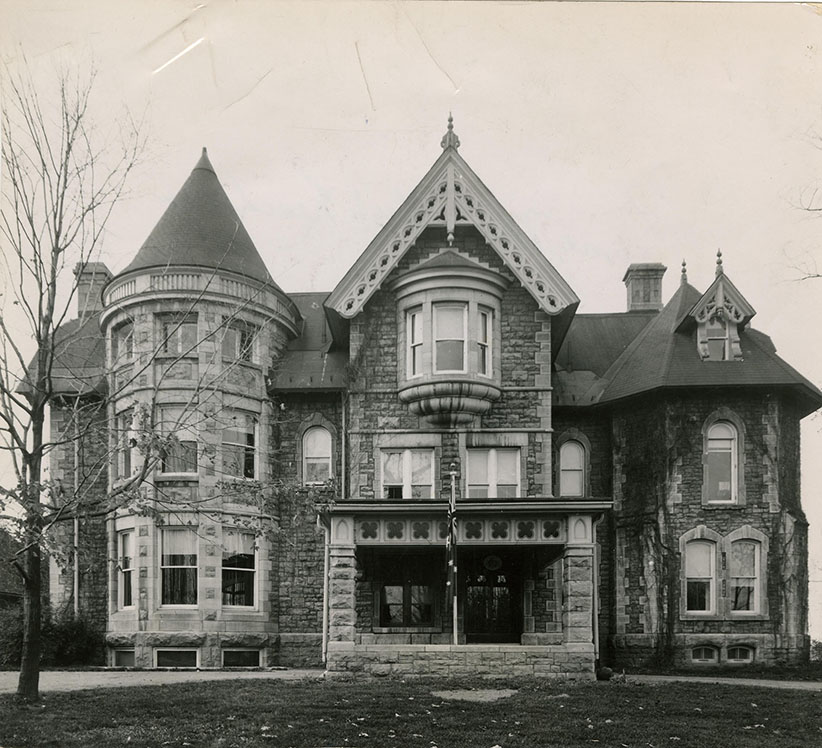
24 Sussex Drive as it appeared before 1950, before it was renovated and transformed into the prime minister’s residence. The 1950-51 renovation removed much of the decoration seen in this photo, including the tower and turret. Credit: Citizen files (The Ottawa Citizen)
The house that was built in the 1860s was designed by the architect J.M. Currier, the brother of the original owner, in the Gothic Revival style. The house has been modified a number of times since. In 1870, a ballroom was added to entertain Prince Arthur, the future Duke of Connaught. Over the years the appearance was altered to add towers, oriel windows, and a porte-cochere entryway. When the house was being renovated for use by the Prime Minister, the design was simplified to the formal, dignified façade which has become well-known to Canadians.

At 24 Sussex – Prime Minister Diefenbaker, President Kennedy, Mrs. Kennedy and Mrs. Diefenbaker. Credit: Library and Archives Canada
In addition to the house with over 30 rooms, the 2.15 hectare property includes a coach house or caretaker’s house and two guard houses. In addition, there is the infamous pool, connected to the main house by an underground tunnel.
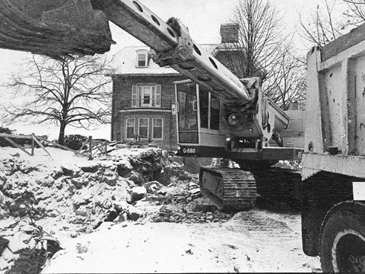
Construction of the swimming pool. Credit: Ottawa Citizen
Making a splash – In 1975, a 20×40 foot pool was installed in a separate purpose-built pool house. The pool cost $200,000. The construction costs were donated by anonymous donors but then-PM Pierre Trudeau took a lot of political heat for the perceived perk.
In 1986, the house was evaluated for its heritage value by the Federal Heritage Buildings Review Office and was designated by the Minister responsible as a Classified Federal Heritage Building. The heritage character statement notes that “The heritage character of 24 Sussex Drive is determined in part by the evolutionary nature of the property.” It further notes that the house is, and should be, the most prominent feature on the property.
Neglect and Deterioration
When the current Prime Minister came to power in 2015, he refused to move into 24 Sussex. His decision brought into focus the years of neglect and slow deterioration that had reduced the house at 24 Sussex from an elegant mansion suitable for entertaining foreign leaders to an uninhabitable one. In 2008, the Auditor General had suggested the Prime Minister move out for a year to make way for the needed work. In 2016, the National Capital Commission (NCC) released a statement assuring Canadians that “We recognize the historic and symbolic importance of the residence of Canada’s Prime Minister and are ensuring that issues related to security, functionality, environmental sustainability, design excellence and heritage preservation are taken into consideration in our preparations.” And yet, nothing happened.
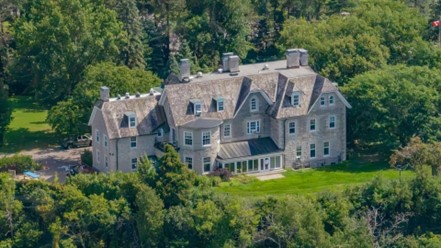
Credit: Radio-Canada / Michel Aspirot
In its 2021 condition report, the NCC described 24 Sussex as being in “critical” condition. In 2023, the NCC finally began the abatement of designated substances such as asbestos, as well as the removal of obsolete mechanical, heating and electrical systems. In February 2024, it was reported that the asbestos, lead paint, mould and rodents were gone.
The house, however, continues to stand empty and, indeed, not in a state to be reoccupied. Why does Canada have such difficulty in providing an adequate official residence to the Prime Minister?
Politics and Rhetoric
Everyone agrees the real problem here is political optics. It is very difficult for a sitting Prime Minister to appear to be spending public money on his home. Past PM’s who invested in 24 Sussex have been criticized in the press and by the opposition, despite the fact that the Leader of the Opposition also lives in an official residence, paid for by taxpayers. This argument seems to overlook the obvious which is that the PM has to live somewhere. That somewhere needs to have adequate security and amenities for the PM to carry out their functions.
Security was improved in the 1990s after an intruder spent over an hour on the grounds of 24 Sussex and accosted the PM and his wife outside their bedroom. PM Jean Chretien, armed only with an Inuit carving, held the intruder at bay until security forces arrived.
24 Sussex is an asset of the nation – it belongs to all of us. But decisions about its care are made by the person who occupies it, which leads to an apparent conflict of interest. Any PM who spends money on the house is perceived as spending money on personal benefit for themself. If decision-making were detached from politics – either by getting all party agreement on a path forward or by distancing the decision-making from elected politicians – agreement to move forward should be possible.
Another argument is that fixing 24 Sussex would cost a lot of money. This argument is made in the absence of an actual plan for what is to be done. Without a plan, it is impossible to estimate cost. Whether the PM lives at 24 Sussex or somewhere else, there will be a cost.
All these are components that have made it difficult to rehabilitate 24 Sussex. Is moving forward even feasible?
It’s not about saving the past
Heritage conservation is not about keeping the past — it is about addressing the needs of today and tomorrow. The issue at 24 Sussex should not be considered as binary: fix it or don’t fix it. It needs to be placed in the matrix of needs and opportunities that exist around this important place.
Rehabilitating the house at 24 Sussex is an opportunity to create something rooted in the past and functional into the future. The heritage value already ascribed to the house reflects change in the past and invites on-going change to support the on-going evolution of the work of a Prime Minister.
At the event on that cold February night, visions for what 24 Sussex could be were shared with the audience. These visions include better serving the state functions that should take place there. They also propose adding new layers of meaning to the place – layers that reflect Indigenous perspectives and welcome Indigenous people, layers that bring the facility to net zero, and layers that capitalize on Canadian architectural and engineering excellence to solve issues like security.
By not moving forward in a positive way at 24 Sussex what does it say about us to each other and to the world? First, it says that we think so little of being Prime Minister of this country that it is okay for that person to do the equivalent of sleeping on the Governor General’s couch for eight years.
Second, it shows that Canada has a real problem with embracing our history and using it as a springboard for the future. If the house or location were truly not suitable for the Prime Minister to live at, then a decision needs to be made to do something else with the place. It is a magnificent location and a fine house – surely some use could be made of it.
Third, 24 Sussex in its dilapidated state reinforces that Canada is not willing to meet the standards of other G7 countries when it comes to heritage. We are the only country without federal legislation to protect heritage. Bill C-23, the Historic Places Act, has been stalled at second reading in the House of Commons for over a year and now risks dying on the order paper. Canada has been working towards federal legislation since at least the early 2000’s with Auditor General reports and Parliamentary committees all pointing to how seriously the current system is broken but, like at 24 Sussex, successive governments have failed to deliver results.
Fourth, the lingering suggestion that it would be the right thing to tear down the house and build a new one shows a frank disregard for the environment. In every other aspect of our lives we strive to reduce, reuse and recycle, but for historic buildings the knee-jerk reaction is to tear down and cart the materials to the landfill. The greenest building is the one that is already there. Capitalizing on its up-front or embodied carbon and improving its on-going energy performance is the only responsible way forward. 24 Sussex is a high-profile opportunity to demonstrate leadership in the reuse of existing buildings.
Moving forward
At the discussion on that cold February night, the crowd left encouraged. 24 Sussex has many positive attributes and it was difficult to find compelling reasons why the building could not be saved. The vision of a Prime Minister’s place of residence that reflects our past and equally represents the Canada we are today did not seem such an unachievable goal. All it will take is our collective commitment to see it happen.
Have you ever wondered what 24 Sussex looks like inside? In this CPAC video, Laureen Harper gives a tour.

